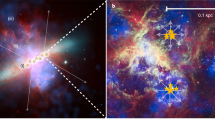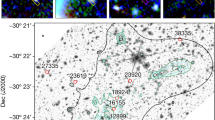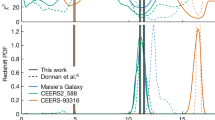Abstract
A NEW round of discussion and experiment has been set off by a recent suggestion made by A. Ward1. He points out that recent developments in physics make possible a laboratory test of a proposal by E. Finlay-Freundlich2 for an alternative interpretation of the galactic red shift. The Finlay-Freundlich hypothesis was based on anomalies in various stellar red shifts and suggested that these, as well as the Hubble-Humason red shift in galactic spectra, commonly interpreted as Doppler shifts in an expanding universe, are in fact the result of loss of energy by observed photons traversing a radiation field. No generally accepted physical mechanism has been proposed for this loss. It may be noted that an as yet unknown photon-photon interaction has been suggested in which the energy lost somehow reappears as lower frequency radiation, or alternatively, it has been proposed that the energy lost reappears as neutrino pairs resulting from the exchange of a graviton between two photons3. The empirical relation first offered by Finlay-Freundlich may be written as:  where ρrad is the energy density in ergs/c.c. of the radiation field traversed by the red-shifted photon, and l is the path length from source to observer. The Finlay-Freundlich hypothesis was attacked strongly when it was made. M.A. Melvin4 and others have emphasized the seemingly serious astronomical counter-evidence, particularly binary star data assembled by H. L. Helfer5. While holding no brief for the relation, Melvin nevertheless revaluated the numerical constant in equation (1) to obtain a better representation of the various data on which Finlay-Freundlich based his relation. The improved version of equation (1) due to Melvin is smaller by 10−3:
where ρrad is the energy density in ergs/c.c. of the radiation field traversed by the red-shifted photon, and l is the path length from source to observer. The Finlay-Freundlich hypothesis was attacked strongly when it was made. M.A. Melvin4 and others have emphasized the seemingly serious astronomical counter-evidence, particularly binary star data assembled by H. L. Helfer5. While holding no brief for the relation, Melvin nevertheless revaluated the numerical constant in equation (1) to obtain a better representation of the various data on which Finlay-Freundlich based his relation. The improved version of equation (1) due to Melvin is smaller by 10−3:  The proposal made by Ward was to verify or disprove equation (2) by an experiment combining the high sensitivity for resonant absorption associated with the Mössbauer effect with the high-radiation fields in a laboratory device for thermonuclear fusion studies.
The proposal made by Ward was to verify or disprove equation (2) by an experiment combining the high sensitivity for resonant absorption associated with the Mössbauer effect with the high-radiation fields in a laboratory device for thermonuclear fusion studies.
This is a preview of subscription content, access via your institution
Access options
Subscribe to this journal
Receive 51 print issues and online access
$199.00 per year
only $3.90 per issue
Buy this article
- Purchase on Springer Link
- Instant access to full article PDF
Prices may be subject to local taxes which are calculated during checkout
Similar content being viewed by others
References
Ward, A., Nature, 192, 858 (1961).
Finlay-Freundlich, E., Phil. Mag., 45, 303 (1954); Proc. Phys. Soc., A, 67, 192 (1954).
Browne, P. F., Nature, 193, 1019 (1962).
Melvin, M. A., Phys. Rev., 98, 884 (1955).
Helfer, H. L., Phys. Rev., 96, 224 (1954).
Weiss, R., and Grodzins, L., Phys. Letters, 1, 342 (1962).
Author information
Authors and Affiliations
Rights and permissions
About this article
Cite this article
ALPHER, R. Laboratory Test of the Finlay-Freundlich Red Shift Hypothesis. Nature 196, 367–368 (1962). https://doi.org/10.1038/196367b0
Issue Date:
DOI: https://doi.org/10.1038/196367b0
Comments
By submitting a comment you agree to abide by our Terms and Community Guidelines. If you find something abusive or that does not comply with our terms or guidelines please flag it as inappropriate.



